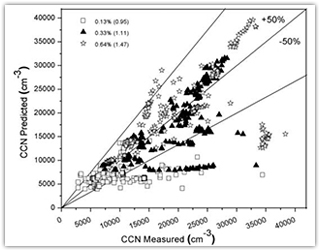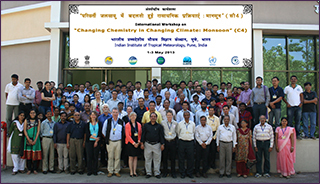Research News
1. First surface and aircraft based cloud condensation nuclei (CCN) closure studies in India
Abstract
First surface and aircraft based CCN closure studies were carried out using a CCN (cloud condensation nuclei) counter (Droplet Measurement Technology) and Scanning Mobility Particle Sizer (TSI), in the years 2008 and 2009 at Kanpur, North India and in 2009 during Indian Continental Tropical Convergence Zone (CTCZ) campaign consisting of total 6 flight sorties, respectively. Due to higher loading of CCN the supersaturation depletion correction was applied. Significant intra-seasonal variability was observed in NCCN and CCN/CN ratio due to different air masses coming from north–west, east, and central parts of India. Higher CCN/CN ratio was observed during winter season when the air mass came from north–west, central, and eastern landmass of India which was due to relatively high accumulation mode particle concentration and large number of forest fires observed in those regions. The polluted continental air masses lead to a significant increase in CCN concentrations over the winter months, most likely due to increased anthropogenic activities, i.e., increased fuel usage, large biomass burning coupled with lower mixed boundary layers. CCN closure study slightly over-predicted the CCN concentration by 21%±18% which was due to lack of size dependent
chemical composition and assumption of internal mixing. However, in aircraft CCN closure (average over-prediction of 1.375), the closure ratio also varied with height and depended greatly on measured CN concentrations. Results of CCN closure improved significantly (overprediction improved by 37.5% and 34.6% for Pantnagar and Gaya, respectively) with the assumption of internally mixed aerosols composed of ammonium sulfate and insoluble organics. Hygroscopicity parameter calculated for the selected sorties (κ= 0.51 and 0.5) indicated the presence of moderately hygroscopic organic species along with some inorganic content.Introduction
Aerosols are defined as fine solid or liquid particles suspended in gas which originated from natural sources viz. windborne dust, sea spray and anthropogenic activities such as combustion of fossil fuels, with size ranging from 0.001μm to 100μm. The particles which have sufficient soluble mass to grow or activate into cloud droplets at atmospheric supersaturation (SS) are termed as the cloud condensation nuclei (CCN). The concentration of CCN can significantly affect cloud microphysical processes, and in turn, several aspects of weather and climate. Higher concentration of CCN leads to formation of droplets of smaller mean diameter, which increases the cloud reflectivity and hence cooling effect (Twomey effect). The second indirect effect is related to the inhibition of precipitation in clouds with small mean
First surface and aircraft based cloud condensation nuclei (CCN) closure studies in India
 Black Carbon science and impacts: Needs for India
International Research News
Report on C4 International Conference
Black Carbon science and impacts: Needs for India
International Research News
Report on C4 International Conference
 Forthcoming Events
Forthcoming Events
Cover Image: (Left) MODIS aerosol optical depth averaged over 2001-2010. Pie charts show the relative contributions of various individual aerosol species as estimated by global model (Courtesy: Myhre et al., 2013, Nature Education Knowledge, 4(5), 7)





